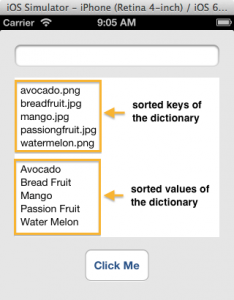An NSDictionary is nothing more than a collection of key-value pairs. The key-value pairs is referred to as an entry. An instance (object) of the NSDictionary class is immutable. This means once you’ve instantiated and initialize a dictionary object, you can’t add new entries or delete existing entries.
NSDictionary Syntax
|
1 |
[NSDictionary dictionaryWithObjectsAndKeys:value, key] |
| NSDictionary | The object’s return type. |
| dictionaryWithObjectsAndKeys: | This method is used to initialize the dictionary. |
| value | This is where you provided the dictionary’s value. |
| key | This is where you provide the dictionary’s key and it is used to access its value. The key must be a unique string. If you provide a key that is already used in the dictionary, the new entry associated with that key is discarded. |
Here are three methods of instantiating and initializing a dictionary object.
// METHOD 1: This is the literal syntax was and it was added recently. Entries are added as key:value pairs
NSDictionary *daysOfTheWeek = @{
@"key1":@"Monday",
@"key2":@"Tuesday",
@"key3":@"Wednesday",
@"key4":@"Thursday",
@"key5":@"Friday",
@"key6":@"Saturday",
@"key7":@"Sunday"};
//METHOD 2: Create arrays of values and keys for the dictionary object.
NSArray *values = @[@"Avocado", @"Mango", @"Water Melon", @"Passion Fruit", @"Bread Fruit"];
NSArray *keys = @[@"avocado.png", @"mango.jpg", @"watermelon.png", @"passiongfruit.jpg", @"breadfruit.jpg"];
// Instantiate a dictionary object, using the values and keys arrays to initialize it
NSDictionary *dicFruits = [NSDictionary dictionaryWithObjects:values forKeys:keys];
// METHOD 3: Instantiate and initialize a dictionary object with (value, key) entries
NSDictionary *cleaningTasks = [NSDictionary dictionaryWithObjectsAndKeys:
@"Remove cobwebs", @"task1",
@"Clean and sanitized counter top", @"task2",
@"Dust picture frames", @"task3",
@"Appliances cleaned and shined",
@"task4", nil];
Common Methods of the NSDictionary Class
The NSDictionary class contain several methods for manipulating instances (objects) of its class. In this section I show you how to use a handful of them.
The objectForKey: method
This method is returns the value of dictionary entry based on the argument provided, which is the entry’s key. Code below demonstrates how how to display a single value of the cleaningTasks dictionary, in the UITextField control.
The allKeys and allValues Method
The allKeys method returns the dictionary’s keys, or an empty array if the dictionary has no entries. The allValues method returns the dictionary’s values, or an empty array if the dictionary has no entries. Code below demonstrates how to use both methods to display the daysOfTheWeek dictionary’s keys and values, in the UITextView control.
Another way you can display a dictionary’s keys and values is to use the NSLog() function in a for loop statement like this.
| Code | Output |
|---|---|
for (NSString *key in daysOfTheWeek) {
// Display the dictionary's keys and values in the Debug window
NSLog(@"%@ %@", key, [daysOfTheWeek valueForKey:key]);
}
|
 |
The keysSortedByValueUsingSelector: Method
This method sorts the dictionary’s keys or values in alphabetical order, then returns an array of the sorted dictionary keys or values. Code below demonstrates how to use the keysSortedByValueUsingSelector: method to sort keys and values of a dictionary, then display them in the UITextView control.
Leave a Reply
You must be logged in to post a comment.



No Responses